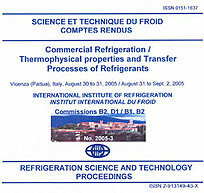
Résumé
R744 has become an important working fluid for several applications. Using a Voorhees supercharge method in a R744 heat pump cycle is an effective way to improve the heating capacity of a heat pump in cold climates or to increase the cooling capacity of a refrigeration system at high ambient temperature conditions. An intermediate pressure receiver (flash tank) arrangement (Voorhees cycle) is studied in this paper, one out of several system design options for realising this concept. To improve the heating capacity of the R744 transcritical cycle at present, a new modified construction of a reciprocating compressor with supercharge ports is introduced. The new concept is compared with the traditional screw or scroll economizer cycles and the losses of the new concept are analyzed. In addition, the optimum discharge pressure, the pressure difference (between discharge pressure and intermediate pressure), mass flow ratio, heating capacity and COPh of the new Voorhees cycle are analyzed and calculated, comparing them to results for the conventional transcritical heat pump cycle. A Voorhees CO2 heat pump cycle is found to have the potential to increase both capacity and COP compared to a conventional CO2 transcritical cycle. (See also this Bulletin, reference 2006-0960.)
Documents disponibles
Format PDF
Pages : 2005-3
Disponible
Prix public
20 €
Prix membre*
Gratuit
* meilleur tarif applicable selon le type d'adhésion (voir le détail des avantages des adhésions individuelles et collectives)
Détails
- Titre original : Study on transcritical R744 (CO2) Voorhees heat pump cycle.
- Identifiant de la fiche : 2006-0962
- Langues : Anglais
- Source : Commercial Refrigeration. Thermophysical Properties and Transfer Processes of Refrigerants. Proceedings of the IIR International Conferences.
- Date d'édition : 30/08/2005
Liens
Voir d'autres communications du même compte rendu (140)
Voir le compte rendu de la conférence
Indexation
-
Experimental study on the heating performance o...
- Auteurs : BAEK C., LEE E., KANG H., et al.
- Date : 14/07/2008
- Langues : Anglais
- Source : 2008 Purdue Conferences. 19th International Compressor Engineering Conference at Purdue & 12th International Refrigeration and Air-Conditioning Conference at Purdue [CD-ROM].
- Formats : PDF
Voir la fiche
-
Scroll compressors with vapour injection in hea...
- Auteurs : WINANDY E., HUNDY G. F.
- Date : 2005
- Langues : Anglais
- Source : Annual proceedings of the Institute of Refrigeration. 2005-2006 [CD-ROM].
Voir la fiche
-
CO2 vapour injected scroll compressors for air ...
- Auteurs : WINANDY E., FONTAINE A. F.
- Date : 29/05/2006
- Langues : Anglais
- Source : 7th IIR-Gustav Lorentzen Conference on Natural Working Fluids (GL2006). Proceedings
- Formats : PDF
Voir la fiche
-
Investigation of transcritical R-744 Voorhees h...
- Auteurs : ZHA S., HAFNER A., NEKSÅ P.
- Date : 29/05/2006
- Langues : Anglais
- Source : 7th IIR-Gustav Lorentzen Conference on Natural Working Fluids (GL2006). Proceedings
- Formats : PDF
Voir la fiche
-
Developing a two-stage rotary compressor for CO...
- Auteurs : YOKOYAMA T., SASAKI K., SEKIYA S., et al.
- Date : 14/07/2008
- Langues : Anglais
- Source : 2008 Purdue Conferences. 19th International Compressor Engineering Conference at Purdue & 12th International Refrigeration and Air-Conditioning Conference at Purdue [CD-ROM].
- Formats : PDF
Voir la fiche
